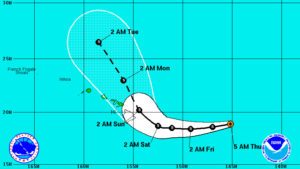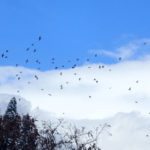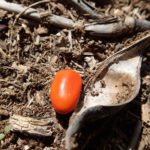 There had been much ado about the approach of Tropical Storm Darby, and I admit part of me was looking forward to something exciting. Since the Aapueo Gulch burned last month we have had a dry summer, with only the briefest of rain showers. Until this morning when the leading spiral band of the approaching storm crossed over Maui. All morning long white veils of fine rain have moved in diagonal sheets across the bleak black landscape.
There had been much ado about the approach of Tropical Storm Darby, and I admit part of me was looking forward to something exciting. Since the Aapueo Gulch burned last month we have had a dry summer, with only the briefest of rain showers. Until this morning when the leading spiral band of the approaching storm crossed over Maui. All morning long white veils of fine rain have moved in diagonal sheets across the bleak black landscape.
I decided to stop looking at satellite images of the storm and go for a walk instead on the flat benchland between the backyards of our street and the edge of the gulch.
There has been so little growth here in the last couple months, mainly some tender blades of grass that have emerged from scattered blackened tussocks, and a few basal sprouts from the charred trunks of shrubs that remain standing. And those few fresh greens have been repeatedly clipped by the forlorn deer that come ambling through.
During the fire nearly all the haole koa shrubs that predominate here were killed. But as a parting gift, their dry pods opened and left thousands of seeds scattered over the land. Like small brown watermelon seeds, they have just sat there baking in the sun, hard and immobile on the dark carpet. Until today. By midday today we had a good soaking, and both earth and seeds are finally hydrated. The seeds have swollen up and softened, and have attracted flocks of well over a hundred spotted doves.
 The grey doves took flight as a group every time I neared them, and then landed further ahead or circled behind me. I realized these are likely the largest flocks of any bird I have seen on the wing in Hawaii! I have seen the albatross gathered on the ground at Kaena Point on Oahu, and small flocks of cattle egrets pass overhead daily. I have seen fluttering groups of little birds in the grassland, and the mynah birds on our roof, but barely anything worth calling a flock. I know some of the northwestern islands are mobbed by roosting sea birds, but what about birds of the uplands? Were there ever large flocks here?
The grey doves took flight as a group every time I neared them, and then landed further ahead or circled behind me. I realized these are likely the largest flocks of any bird I have seen on the wing in Hawaii! I have seen the albatross gathered on the ground at Kaena Point on Oahu, and small flocks of cattle egrets pass overhead daily. I have seen fluttering groups of little birds in the grassland, and the mynah birds on our roof, but barely anything worth calling a flock. I know some of the northwestern islands are mobbed by roosting sea birds, but what about birds of the uplands? Were there ever large flocks here?
 Also puffed up by the moisture are the brilliant red seeds of the wiliwili tree. There aren't many of these, maybe a dozen or two scattered beneath a parent tree. Hopefully some of the pinto bean-sized seeds will sprout and take hold. I see no young wiliwili in the gulch, only the elders' with their yellow bark and fat thorns, scarred and deformed by prior insect attacks. It may be my imagination but it appears that the bark on the canopy limbs is more greenish than normal -- maybe a photosynthetic response to the fire? Or just a way to soak in solar energy in the dry times.
Also puffed up by the moisture are the brilliant red seeds of the wiliwili tree. There aren't many of these, maybe a dozen or two scattered beneath a parent tree. Hopefully some of the pinto bean-sized seeds will sprout and take hold. I see no young wiliwili in the gulch, only the elders' with their yellow bark and fat thorns, scarred and deformed by prior insect attacks. It may be my imagination but it appears that the bark on the canopy limbs is more greenish than normal -- maybe a photosynthetic response to the fire? Or just a way to soak in solar energy in the dry times.
In a hopeful sign, one of the trees that was caught in the fire and sports a blackened trunk has put out some new growth with pale green leaflets. I am always rooting for the survival of the wiliwili here, especially since they are the main reminder of the diverse tropical dry forest that once covered the lower leeward slopes of Haleakala.
As for an exciting storm, I was only hit by only a couple decent gusts, and then the sun came out.

You must log in to post a comment.